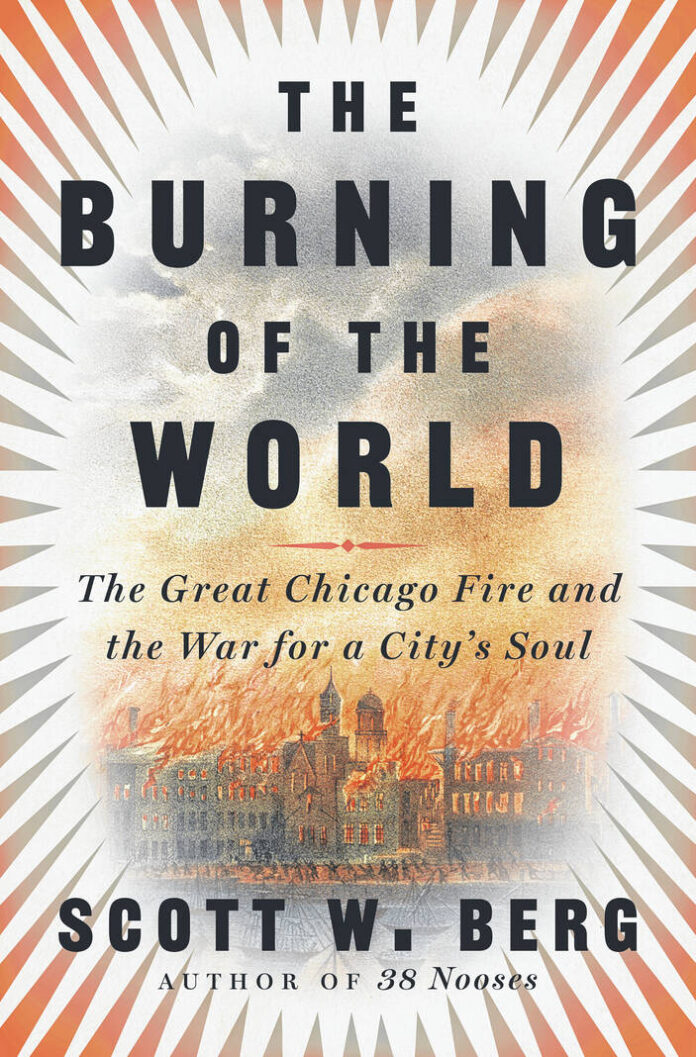NONFICTION: Scott W. Berg’s “The Burning of the World,” about the Great Chicago Fire, joins an exceptional list.
Burning books = bad. Books about burning = almost inevitably good.
There may not be enough books about fighting fires to qualify as a genre, but there are a lot of good ones. Whether they’re in the wilds of Montana or the middle of a great city — like Twin Cities native Scott W. Berg’s new “The Burning of the World,” about the Great Chicago Fire of 1871 — they’re drama-filled tales that show humans at their best and worst. Helpfully for writers, they also tend to leave behind lots of documentation.
Here’s what to expect from Berg’s new book and other burning books to look for at your library:
In “The Burning of the World” Berg covers the same ground as most of these books — What started the fire? How did it progress? What happened afterward? — on the way to showing how Chicago became one of America’s great cities. The 1871 fire torched Chitown when it was just three decades old, and ended up accelerating its rapid growth.
The first third of “Burning” grapples with the disaster that wiped out about a third of Chicago, but also details that the drought-ridden Windy City was so fire-prone that it could more accurately have been dubbed the Woody City.
Berg is great on ironic details. I can’t stop thinking about steam-powered fire engines having wood-burning stoves that needed to be stoked even while they were fighting fires, or that Chicago fighters pulled fenceposts out of the ground to fuel engines since the posts were about to burn anyway. I will say, though, that the final two-thirds of the book, which tracks the city’s rebound, isn’t as impossible to put down.
“Young Men and Fire,” Norman Maclean (1992). Not just the best account of a fire but one of the finest books ever written about anything, “Young Men” is two-pronged. Half focuses on the brave adventurers who parachuted onto a Montana mountain in 1949 to battle a huge fire. Using his own observations and survivors’ memories, Maclean’s gripping work helped change how fires are understood. Even better, as Maclean (who wrote “A River Runs Through It”), pieces together the firefighters’ actions, “Young Men and Fire” becomes a book about finding meaning in tragedy.
“The Circus Fire,” Stewart O’Nan (2002). Believe it or not, Barnum & Bailey used a combination of gasoline and paraffin to waterproof circus tents. Which is why attendees at a 1944 performance in Connecticut quickly found themselves in the middle of what was essentially a giant lantern. O’Nan tells stories of heroism, compassion and amazing escapes, but he also accounts for the grief that followed the tragedy in a section of the book set at a large, de facto morgue. Loved ones came to walk through rows of bodies, trying to identify the charred victims (a similar section appears in Berg’s book).
“The Big Burn,” Timothy Egan (2009). Egan, who wrote this year’s sensational “A Fever in the Heartland,” describes a 1910 forest fire in Washington, Montana and Idaho. Unlike others on this list, the engrossing, minute-by-minute account is not the heart of Egan’s book. Instead, it’s about how politicians, including Teddy Roosevelt, used one of the worst wildfires in U.S. history to champion the creation of a national forest service.
“Under a Flaming Sky,” Daniel James Brown (2006). This page-turner, subtitled “The Great Hinckley Firestorm of 1894,” puts us right on the scene as an enormous blaze consumes much of central Minnesota. Using survivor accounts, Brown (who later wrote bestselling “The Boys in the Boat”) put together a moment-by-moment recap of the tragedy, its more than 400 victims and its heroes, including a train porter who calmly supervised one of the only means of escape.
“Triangle: The Fire That Changed America,” David Von Drehle (2004). The usual villains appear in this riveting, achingly sad book: corporate indifference, inadequate safety, greed. There’s also sexism, since the victims of the 1911 Greenwich Village fire were female employees at a blouse factory (the building still stands). Von Drehle’s details are astonishing — Who missed the last elevator down? Who fled to the roof? — but he doesn’t lose track of the larger story. When the world learned about Triangle’s shoddy safety measures, protests led to the creation of the Occupational Safety and Health Administration.
“Ship Ablaze: The Tragedy of the Steamboat General Slocum,” Edward T. O’Donnell (2003). Most have never heard of the burning of the General Slocum but until the Sept. 11 attacks it was New York’s worst tragedy. More than 1,000 people died in a fire that — apparently started by a cigarette — occurred in the East River, within a football throw of the Manhattan shoreline. O’Donnell traces what led passengers to the ship — most were headed to a church picnic — and the shocking safety lapses (poorly made life preservers, inadequate lifeboats, untrained crew) that increased the fire’s appalling toll.







